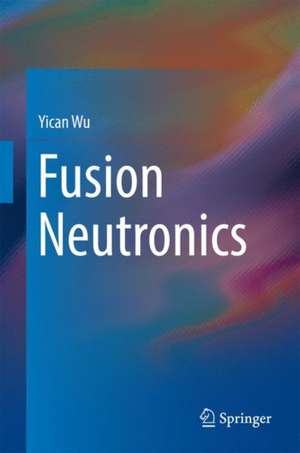Fusion Neutronics
Autor Yican Wuen Limba Engleză Hardback – 24 aug 2017
Compared with other nuclear devices such as fission reactors and accelerators, fusion systems are normally characterized by their complex geometry and nuclear physics, which entail new challenges for neutronics such as complicated modeling, deep penetration, low simulation efficiency, multi-physics coupling, etc. The book focuses on the neutronic characteristics of fusion systems and introduces a series of theories and methodologies that were developed to address the challenges of fusion neutronics. Further, it introduces readers to the unique principles and procedures of neutronics design, experimental methodologies and methodologies for fusion systems.
The book not only highlights the latest advances and trends in the field, but also draws on the experiences and skills collected in the author’s more than 40 years of research. To make it more accessible and enhance its practical value, various representative examples are included to illustrate the application and efficiency of the methods, designs and experimental techniques discussed.
| Toate formatele și edițiile | Preț | Express |
|---|---|---|
| Paperback (1) | 952.09 lei 6-8 săpt. | |
| Springer Nature Singapore – 12 dec 2018 | 952.09 lei 6-8 săpt. | |
| Hardback (1) | 963.60 lei 6-8 săpt. | |
| Springer Nature Singapore – 24 aug 2017 | 963.60 lei 6-8 săpt. |
Preț: 963.60 lei
Preț vechi: 1175.12 lei
-18% Nou
Puncte Express: 1445
Preț estimativ în valută:
184.38€ • 193.03$ • 152.57£
184.38€ • 193.03$ • 152.57£
Carte tipărită la comandă
Livrare economică 05-19 aprilie
Preluare comenzi: 021 569.72.76
Specificații
ISBN-13: 9789811054686
ISBN-10: 9811054681
Pagini: 450
Ilustrații: XX, 393 p. 192 illus., 110 illus. in color.
Dimensiuni: 155 x 235 mm
Greutate: 0.97 kg
Ediția:1st ed. 2017
Editura: Springer Nature Singapore
Colecția Springer
Locul publicării:Singapore, Singapore
ISBN-10: 9811054681
Pagini: 450
Ilustrații: XX, 393 p. 192 illus., 110 illus. in color.
Dimensiuni: 155 x 235 mm
Greutate: 0.97 kg
Ediția:1st ed. 2017
Editura: Springer Nature Singapore
Colecția Springer
Locul publicării:Singapore, Singapore
Cuprins
Introduction.- Part I Neutronic Theories and Methodologies for Fusion Neutron Transport Theory and Simulation.- Neutron-induced Transmutation and Activation.- Neutron Irradiation and Material Damage.- Radiation Dosimetry and Biological Safety.- Fusion Nuclear Data Libraries.- Comprehensive Neutronic Simulation.- Part II Fusion Neutronic Design Principles Neutronic Design of Fusion Experimental Reactors.- Neutronic Design Principles for DEMO Reactors and Fusion Power Reactors.- Neutronic Design Principles for Fusion-Fission Hybrid Reactors.- Part III Fusion Neutronic Experimental Technologies Experimental Methods of Fusion Neutronics.- Fusion Neutronic Experimental Facilities.- Fusion Neutronic Experiments.
Notă biografică
Prof. Yican Wu is the director general of Institute of Nuclear Energy Safety Technology, Chinese Academy of Sciences (CAS), the director of Key Laboratory of Neutronics and Radiation Safety, CAS, and the leader of FDS Team. He has been serving as the Executive Committee Chair of IEA ESEFP TCP and IAEA consultant. His research involves nuclear science and engineering, nuclear safety and other interdisciplinary research. He has published over 400 papers and received over 10 important awards including the National Natural Science Award and the Science and Technology Award of China Nuclear Energy Association.
Textul de pe ultima copertă
This book provides a systematic and comprehensive introduction to fusion neutronics, covering all key topics from the fundamental theories and methodologies, as well as a wide range of fusion system designs and experiments. It is the first-ever book focusing on the subject of fusion neutronics research.
Compared with other nuclear devices such as fission reactors and accelerators, fusion systems are normally characterized by their complex geometry and nuclear physics, which entail new challenges for neutronics such as complicated modeling, deep penetration, low simulation efficiency, multi-physics coupling, etc. The book focuses on the neutronics characteristics of fusion systems and introduces a series of theories and methodologies that were developed to address the challenges of fusion neutronics, and which have since been widely applied all over the world. Further, it introduces readers to neutronics design’s unique principles and procedures, experimental methodologies and technologies for fusion systems.
The book not only highlights the latest advances and trends in the field, but also draws on the lessons learned in the author’s more than 40 years of research. To make it more accessible and enhance its practical value, various representative examples are included to illustrate the application and efficiency of the methods, designs and experimental techniques discussed.
Compared with other nuclear devices such as fission reactors and accelerators, fusion systems are normally characterized by their complex geometry and nuclear physics, which entail new challenges for neutronics such as complicated modeling, deep penetration, low simulation efficiency, multi-physics coupling, etc. The book focuses on the neutronics characteristics of fusion systems and introduces a series of theories and methodologies that were developed to address the challenges of fusion neutronics, and which have since been widely applied all over the world. Further, it introduces readers to neutronics design’s unique principles and procedures, experimental methodologies and technologies for fusion systems.
The book not only highlights the latest advances and trends in the field, but also draws on the lessons learned in the author’s more than 40 years of research. To make it more accessible and enhance its practical value, various representative examples are included to illustrate the application and efficiency of the methods, designs and experimental techniques discussed.
Caracteristici
Provides a systematic and comprehensive introduction to fusion neutronics, an extremely important branch of fusion research
Includes detailed introductions to neutronic theories and methods that are suitable for fusion application given their unique neutronic characteristics
Shares essential experiences collected in the neutronic design of fusion systems with abundant examples
Highlights the key challenges in fusion neutronic experiments
Includes supplementary material: sn.pub/extras
Includes detailed introductions to neutronic theories and methods that are suitable for fusion application given their unique neutronic characteristics
Shares essential experiences collected in the neutronic design of fusion systems with abundant examples
Highlights the key challenges in fusion neutronic experiments
Includes supplementary material: sn.pub/extras
